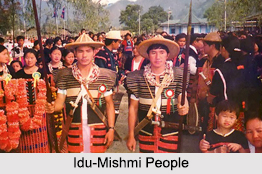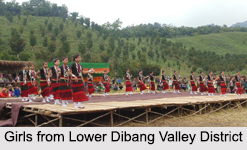 People of Lower Dibang Valley District in Arunachal Pradesh include various indigenous tribes of this part of the country like Galo Tribe, Adi and Mishing and Mishmi tribes. The Lower Dibang Valley district is an administrative district in the state of Arunachal Pradesh in north-eastern India. It is the 10th least populous district in the country. The Lower Dibang Valley district, with its headquarter at Roing is the 17th district of Arunachal Pradesh. It forms a division of eastern Arunachal Pradesh. It is named after the river Dibang which is one of the significant tributaries of the mighty Brahmaputra.
People of Lower Dibang Valley District in Arunachal Pradesh include various indigenous tribes of this part of the country like Galo Tribe, Adi and Mishing and Mishmi tribes. The Lower Dibang Valley district is an administrative district in the state of Arunachal Pradesh in north-eastern India. It is the 10th least populous district in the country. The Lower Dibang Valley district, with its headquarter at Roing is the 17th district of Arunachal Pradesh. It forms a division of eastern Arunachal Pradesh. It is named after the river Dibang which is one of the significant tributaries of the mighty Brahmaputra.
Languages of Lower Dibang Valley District
Languages spoken by the people of Lower Dibang Valley District include Idu Mishmi and Adi, an endangered Sino-Tibetan tongue.
Culture of Lower Dibang Valley District
 People of Lower Dibang Valley District still keep up the deep-rooted aesthetic values in their day-to-day life with huge pride and honour. They believe the all pervading divinity Nani-Intaya is the sole originator of the universe. Usually, Idu Mishmi is a group of major sub-tribe of Mishmi group from Lower Dibang Valley District which believes in animism. They worship quite a few numbers of malicious spirits. Nani-Intaya and Masello Zino are worshipped as creators of mankind and universe as in one piece.
People of Lower Dibang Valley District still keep up the deep-rooted aesthetic values in their day-to-day life with huge pride and honour. They believe the all pervading divinity Nani-Intaya is the sole originator of the universe. Usually, Idu Mishmi is a group of major sub-tribe of Mishmi group from Lower Dibang Valley District which believes in animism. They worship quite a few numbers of malicious spirits. Nani-Intaya and Masello Zino are worshipped as creators of mankind and universe as in one piece.
The major festivals of Idu Mishmi are "Reh" and "Ke-meh-ha". Reh festival is held during the month of February. It is an event for people to settle down, enjoy, dance, eat and drink. The Idu women are very fine weavers. A well-developed civilization dated back in the pages of history can be found in the area. Residues of 10th Century AD found at Bhismaknagar, Chidu and Chimri villages in the lower line of the district establish that the Idus coexisted with vast harmony with the people of plains and neighbouring states. The Idu-Mishmi society is patriarchal.
The property is inherited by the son from the father. The house of Idu-Mishmi is a stretched one like a bus, rectangular in size which is raised above two feet from the ground and supported on wooden posts. Bamboo, cane, wood and leaves of toku and straws are used for structure. Rice, Maize and Millet are the staple food of the Idu–Mishmis. Sweet potato and different kinds of vegetable are the common crops.
The local inhabitants residing in Lower Dibang Valley are quite colourful, following diverse traditions and cultures. The valley region exudes unparallel charm, in the form of lush green hills, gushing rivers, spectacular valleys of the Himalayan mountain ranges and picturesque hills.



















